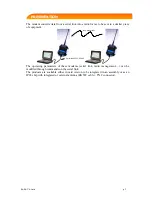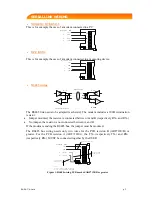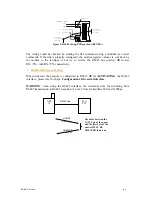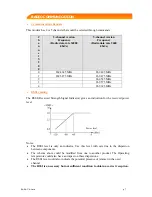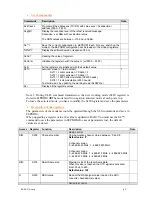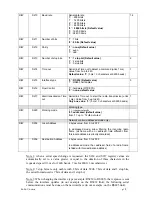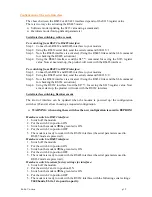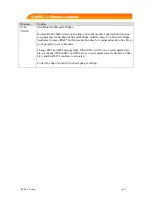
06-06-V6-smn
p10
R/W
S210
Baud rate
Serial data rate
‘0’ : 600 bits/s
‘1’ : 1 200 bits/s
‘2’ : 2 400 bits/s
‘3’ : 4 800 bits/s
‘4’ : 9 600 bits/s (Default value)
‘5’ : 19 200 bits/s
‘6’ : 38 400 bits/s
1, 4
R/W
S211
Number of bits
‘7’ : 7 bits
‘8’ : 8 bits (Default value)
R/W S212
Parity
‘1’ : none (Default value)
‘2’ : even
‘3’ : odd
R/W
S213
Number of stop bits
‘1’ : 1 stop bit (Default value)
‘2’ : 2 stop bits
‘3’ : 3 stop bits
2
R/W
S214
Time out
Serial link Time out to detect a command (units 1 ms).
Value from 3 up to 240.
Default value: ‘3’
(3 ms = 3 characters at 9600 bauds)
1
R/W S215
Interface
type
‘0’ : RS232 (Default value)
‘1’ : RS485 half duplex
3
R/W S216
Flow
Control
‘0’ : hardware (RTS/CTS)
‘2’ : none, default value
R/W
S217
Start transmission Time
out
Serial link Time out to start the radio transmission (units
1 ms). Value from 3 up to 240.
Only one value: ‘3’
(3 ms = 3 characters at 9600 bauds)
1
Working type
R/W S220
Working
mode
‘1’= transparent
mode
‘6’= addressed (default value)
from ‘11’ up to ‘14’
Î
auto-test
Network control (addressed mode only)
R/W
S252
Local Address
2 bytes value, from 0 to FFFF
In addressed mode, allow filtering the incoming radio
frame (all frame with an <address> field different from
this local address are silently discarded)
R/W
S256
Destination Address
2 bytes value, from 0 to FFFF
In addressed mode, the <address> field of a radio frame
is filled with this destination address)
Note 1: when a serial speed change is requested, the S214 and S217 register values are
automatically set to a value greater or equal to the duration of three characters in the
requested speed (13 ms for 2400 bauds, 7 ms for 4800, 3 ms otherwise).
Note 2: 3 stop bits are only usable with 8 bits of data. With 7 bits of data and 3 stop bits,
the serial format used is 7 bits of data and 1 stop bit.
Note 3: When changing the interface type (example: RS232 to RS485), the response is sent
before the interface updates (in our example on the RS232 link); the following serial
communications must be done on the new interface (in our example, on the RS485 link).



